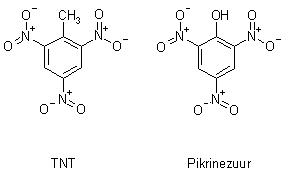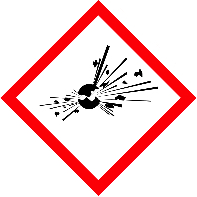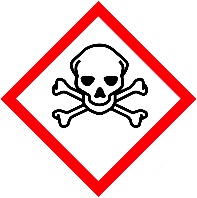
 |
| De structuur formule van pikrinezuur naast die van TNT. |
INHOUD:
Hieronder staan een aantal gegevens die betrekking hebben op de gevaren van pikrinezuur.
| Naam: | Pikrinezuur, picrinezur | |
| 2,4,6-Trinitrofenol | ||
| 1-hydroxy-2,4,6-trinitrobenzeen | ||
| Formule: | HOC6H2(NO2)3 | |
| Smeltpunt: | 122 °C | |
| Oplosbaarheid in water: | 1,4 g/100 ml | |
| Ontledingstemperatuur: | beneden het kookpunt (ca. 215°C) | |
| CAS-nummer: | 88-89-1 | |
| Grenswaarden: | Wettelijk: 0,1 mg/m3 | |
| H-zinnen: | 201-(301+311+331) | |
| P-zinnen: | 210-280-(301+3100-312 | |
| Etiket: |  GHS01 Signaalwoord: GEVAAR |
 GHS06 |
| Toxiciteit: | Oraal LD50: 200 mg/kg (rat) | |
| Reacties: | Ontleedt explosief onder vorming van giftige gassen (o.a. CO en NO2). De stof is een sterk oxidatiemiddel en reageert heftig met reducerende en brandbare stoffen met kans op brand en explosie. In water opgelost in pikrine zuur een sterk zuur en reageert heftig met basen. De stof is corrosief. Pikrinezuur reageert met veel metalen, waarbij waterstofgas ontstaat. Spontane verbranding treedt op als de stof reageert met aluminium bij aanwezigheid van vocht. Pikrinezuur is zeer brandgevaarlijk. | |
| Explosiegevaar: | Fijn verdeeld stof is met lucht explosief, kans op explosie door wrijven, stoten of verhitting. | |
| Emergency Overview:
..."DANGER! KEEP WET. EXPLOSIVE IF DRY. FLAMMABLE SOLID. CAUSES SEVERE EYE IRRITATION. HARMFUL IF SWALLOWED...." |
Pikrinezuur staat op de lijst van ontploffingsgevaarlijke stoffen van het Afleveringsbesluit ontploffingsgevaarlijke stoffen (Stcrt. 228, 1979). Op deze lijst zien wij ook een aantal bekende explosieven, waaronder: TNT, glyceroltrinitraat (nitroglycerine), pikraminezuur, knalkwik, nitrocellulose en pikrinezuur. Ook de zouten van pikrinezuur staan op deze lijst.
Zijn er op laboratoriumschaal (of in het onderwijs) praktijkvoorbeelden bekend van ongelukken met pikrinezuur? Ik ken ze niet, maar ongetwijfeld bestaan ze, maar ik kan ze nergens vinden. De cases die ik hier bespreek hebben betrekking op de aanwezigheid van pikrinezuur op ongewenste plaatsen.
Tot twee keer toe ben ik pikrinezuur tegengekomen in de chemicaliėnvoorraad van een school. De eerste keer, dat was zeker 10 jaar geleden, wees ik mijn collega van de sectie biologie van de middelbare school waar ik werk, op een potje met pikrinezuur. Het potje was duidelijk gevuld met mooie gele kristallen. Toen ik mijn collega op de gevaren daarvan wees, met name op de explosiviteit van pikrinezuur, wilde zij mij in eerste instantie niet geloven, vooral omdat zij gewend was de stof al jarenlang te gebruiken. Later zag zij ook de gevaren in. We hebben water bij de pikrinezuur gedaan, en vervolgens afgevoerd met het chemisch afval.
De tweede keer dat ik droog pikrinezuur tegenkwam, was tijdens een periode dat een collega van een andere locatie, bezig was met saneren van de chemicaliėnvoorraad. Ook hier dook een potje met de gele kristallen op. Ik adviseerde om de stof direct nat te maken en af te voeren met het chemisch afval.
Bijdrage: de auteur.
"..DISCOVERY OF PICRIC ACID IN EXPLOSIVE CONDITION
On September 17, 1996, at the Savannah River Site, a
laboratory technician found a bottle containing
approximately 8 ounces (1 ounce= 28,35 gram: auteur)
of picric acid with some crystallized particles. Picric acid
is normally shipped in a solid form and can be safely
handled and stored as a solid or when it is dissolved in
water. However, if picric acid solutions become dry, through
evaporation to the point where crystals form, there is a
strong potential for an explosion hazard. The laboratory
technician found picric acid in an explosive form. (ORPS
Report SR--WSRC-LTA-1996-0033) The laboratory technician
called the fire department and notified building operations.
Facility operations managers and operators relocated
personnel working in the section where the acid was found,
and the section was barricaded. The Department of Energy
Savannah River Office contacted the South Carolina State Law
Enforcement Division for assistance with disposal of the
chemical. Enforcement officers responded and took the acid
to a safe site location to detonate it....."
Bron: Website van de Amerikaanse overheid: Department of Energy's Operating Experience (DOE) (Link is dood)
"...PICRIC ACID FOUND IN CRAWL SPACE AT HANFORD
On January 28, 1998, at the Hanford 327 Facility, a
maintenance crew discovered a small vial labeled "picric
acid" in a crawl space while they were performing a pre-job
walk-down for maintenance on some steam lines. Picric acid
is normally used as an aqueous solution and an explosive
mixture results when the solution crystallizes. The facility
manager evacuated the facility, and the Hanford deputy
manager declared an alert level emergency. An "alert" is the
lowest level of emergency classification. After
investigators determined worst-case potential consequences,
the basis for declaring the alert was no longer valid and
the deputy manager cancelled the alert. Facility personnel
reported that no one was injured, no damage occurred to the
facility or equipment, and there was no release of materials
to the environment..."
"...Facility emergency response personnel developed a written plan and performed a dry run to put the material in a safe status. Following the dry run, two hazardous material specialists from the Hanford fire department, dressed in "bunker gear" and fire-rated, self-contained breathing apparatus, entered the crawl space and transferred the vial to a bucket containing water.
During the investigation, the maintenance crew leader recalled that the clear plastic vial was approximately 3 inches long and 1 inch in diameter, with a white plastic lid. He stated that the vial was approximately two-thirds full of a white granular substance. The label identified the contents as picric acid, and indicated the date as 1988. Investigators have not determined how the vial of material got into the crawl space. Investigators are determining lessons learned for this event and are evaluating the site emergency response actions to determine if improvements are required..."
Bron: Website van de Amerikaanse overheid: Department of Energy's Operating Experience (DOE) (Link is dood)
COMMENTAAR OP DE LAATSTE TWEE CASES. De schrijver is hiervan niet echt zorgvuldig geweest. In casus 2 wordt beweerd dat pikrinezuur als vaste stof is te transporteren of op te slaan. Dit is, zoals we in het voorgaande kunnen lezen, alleen juist als de pikrinezuur is bevochtigd met minimaal 20% water. Een verzadigde oplossing van pikrinezuur is veilig te vervoeren en op te slaan. Omdat een verzadigde oplossingen kristallen bevat hoeft dit niet direkt gevaar op te leveren. Waarschijnlijk doelt men op een potentieel gevaar voor het geval dat een oplossing van pikrinezuur helemaal zou droogdampen.